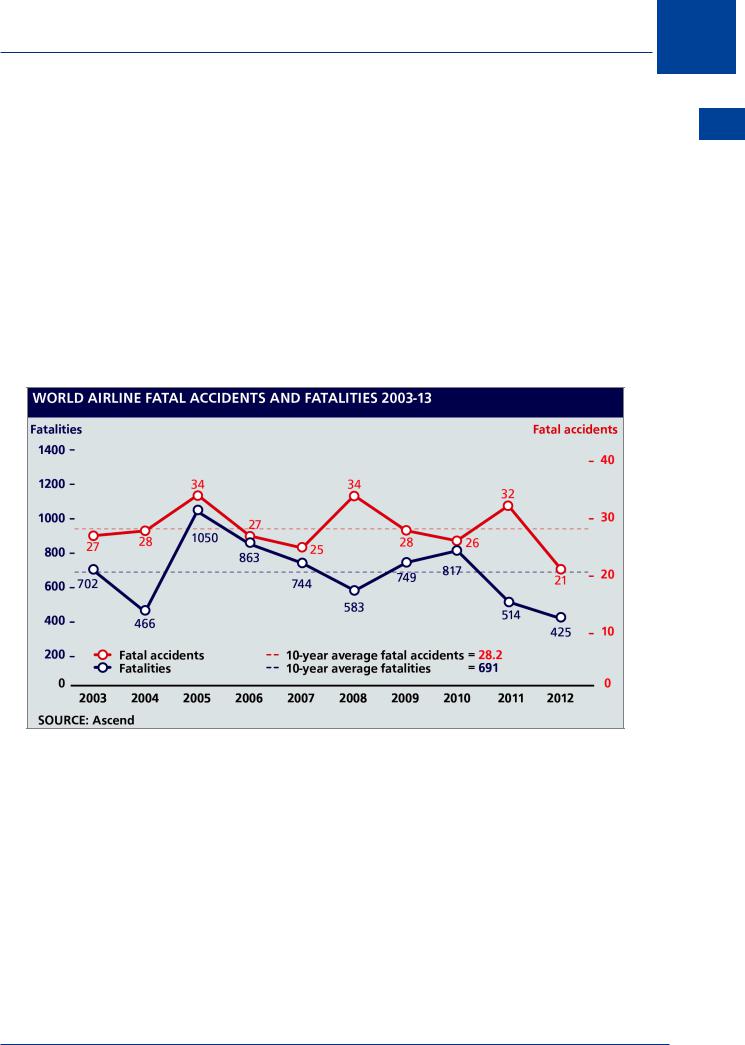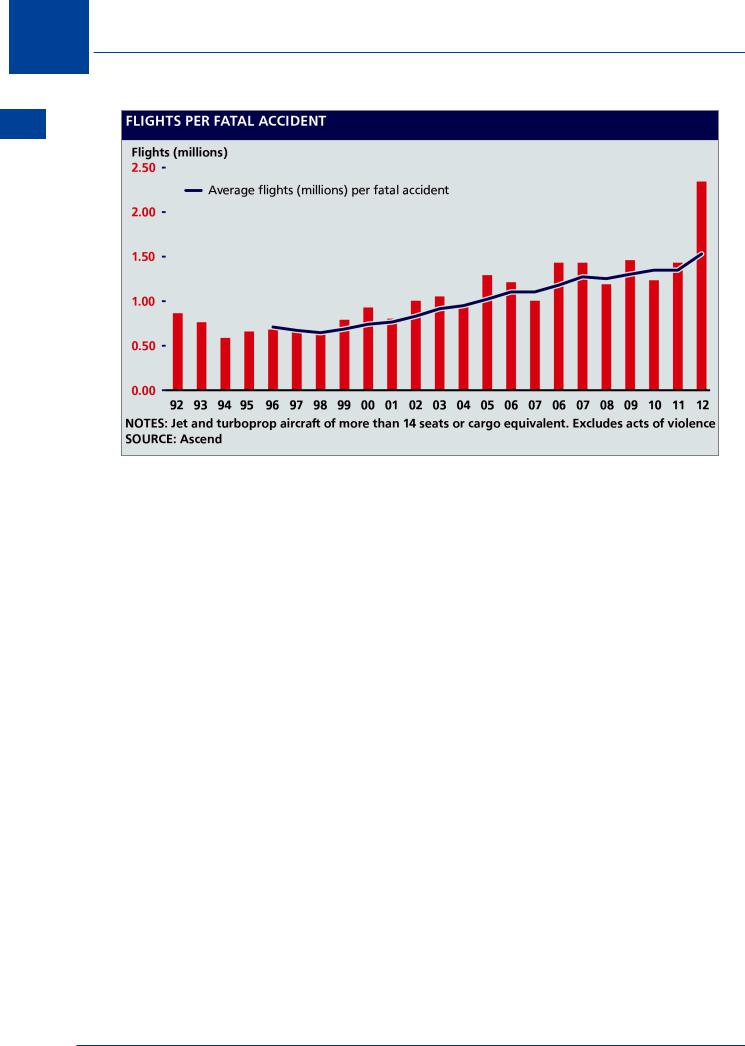
- •Textbook Series
- •Contents
- •1 Basic Concepts
- •The History of Human Performance
- •The Relevance of Human Performance in Aviation
- •ICAO Requirement for the Study of Human Factors
- •The Pilot and Pilot Training
- •Aircraft Accident Statistics
- •Flight Safety
- •The Most Significant Flight Safety Equipment
- •Safety Culture
- •Reason’s Swiss Cheese Model
- •The Five Elements of Safety Culture
- •Flight Safety/Threat and Error Management
- •Threats
- •Errors
- •Undesired Aircraft States
- •Duties of Flight Crew
- •2 The Circulation System
- •Blood Circulation
- •The Blood
- •Composition of the Blood
- •Carriage of Carbon Dioxide
- •The Circulation System
- •What Can Go Wrong
- •System Failures
- •Factors Predisposing to Heart Attack
- •Insufficient Oxygen Carried
- •Carbon Monoxide
- •Smoking
- •Blood Pressure
- •Pressoreceptors and their Function Maintaining Blood Pressure
- •Function
- •Donating Blood and Aircrew
- •Pulmonary Embolism
- •Questions
- •Answers
- •3 Oxygen and Respiration
- •Oxygen Intake
- •Thresholds of Oxygen Requirements Summary
- •Hypoxic Hypoxia
- •Hypoxic Hypoxia Symptoms
- •Stages/Zones of Hypoxia
- •Factors Determining the Severity of and the Susceptibility to Hypoxic Hypoxia
- •Anaemic Hypoxia
- •Time of Useful Consciousness (TUC)
- •Times of Useful Consciousness at Various Altitudes
- •Effective Performance Time (EPT)
- •Hyperventilation
- •Symptoms of Hyperventilation
- •Hypoxia or Hyperventilation?
- •Cabin Pressurization
- •Cabin Decompression
- •Decompression Sickness (DCS)
- •DCS in Flight and Treatment
- •Questions
- •Answers
- •4 The Nervous System, Ear, Hearing and Balance
- •Introduction
- •The Nervous System
- •The Sense Organs
- •Audible Range of the Human Ear and Measurement of Sound
- •Hearing Impairment
- •The Ear and Balance
- •Problems of Balance and Disorientation
- •Somatogyral and Somatogravic Illusions
- •Alcohol and Flying
- •Motion Sickness
- •Coping with Motion Sickness
- •Questions
- •Answers
- •5 The Eye and Vision
- •Function and Structure
- •The Cornea
- •The Iris and Pupil
- •The Lens
- •The Retina
- •The Fovea and Visual Acuity
- •Light and Dark Adaptation
- •Night Vision
- •The Blind Spot
- •Stereopsis (Stereoscopic Vision)
- •Empty Visual Field Myopia
- •High Light Levels
- •Sunglasses
- •Eye Movement
- •Visual Defects
- •Use of Contact Lenses
- •Colour Vision
- •Colour Blindness
- •Vision and Speed
- •Monocular and Binocular Vision
- •Questions
- •Answers
- •6 Flying and Health
- •Flying and Health
- •Acceleration
- •G-forces
- •Effects of Positive G-force on the Human Body
- •Long Duration Negative G
- •Short Duration G-forces
- •Susceptibility and Tolerance to G-forces
- •Summary of G Tolerances
- •Barotrauma
- •Toxic Hazards
- •Body Mass Index (BMI)
- •Obesity
- •Losing Weight
- •Exercise
- •Nutrition and Food Hygiene
- •Fits
- •Faints
- •Alcohol and Alcoholism
- •Alcohol and Flying
- •Drugs and Flying
- •Psychiatric Illnesses
- •Diseases Spread by Animals and Insects
- •Sexually Transmitted Diseases
- •Personal Hygiene
- •Stroboscopic Effect
- •Radiation
- •Common Ailments and Fitness to Fly
- •Drugs and Self-medication
- •Anaesthetics and Analgesics
- •Symptoms in the Air
- •Questions
- •Answers
- •7 Stress
- •An Introduction to Stress
- •The Stress Model
- •Arousal and Performance
- •Stress Reaction and the General Adaption Syndrome (GAS)
- •Stress Factors (Stressors)
- •Physiological Stress Factors
- •External Physiological Factors
- •Internal Physiological Factors
- •Cognitive Stress Factors/Stressors
- •Non-professional Personal Factors/Stressors
- •Stress Table
- •Imaginary Stress (Anxiety)
- •Organizational Stress
- •Stress Effects
- •Coping with Stress
- •Coping with Stress on the Flight Deck
- •Stress Management Away from the Flight Deck
- •Stress Summary
- •Questions
- •Answers
- •Introduction
- •Basic Information Processing
- •Stimuli
- •Receptors and Sensory Memories/Stores
- •Attention
- •Perception
- •Perceived Mental Models
- •Three Dimensional Models
- •Short-term Memory (Working Memory)
- •Long-term Memory
- •Central Decision Maker and Response Selection
- •Motor Programmes (Skills)
- •Human Reliability, Errors and Their Generation
- •The Learning Process
- •Mental Schema
- •Questions
- •Answers
- •9 Behaviour and Motivation
- •An Introduction to Behaviour
- •Categories of Behaviour
- •Evaluating Data
- •Situational Awareness
- •Motivation
- •Questions
- •Answers
- •10 Cognition in Aviation
- •Cognition in Aviation
- •Visual Illusions
- •An Illusion of Movement
- •Other Sources of Illusions
- •Illusions When Taxiing
- •Illusions on Take-off
- •Illusions in the Cruise
- •Approach and Landing
- •Initial Judgement of Appropriate Glideslope
- •Maintenance of the Glideslope
- •Ground Proximity Judgements
- •Protective Measures against Illusions
- •Collision and the Retinal Image
- •Human Performance Cognition in Aviation
- •Special Situations
- •Spatial Orientation in Flight and the “Seat-of-the-pants”
- •Oculogravic and Oculogyral Illusions
- •Questions
- •Answers
- •11 Sleep and Fatigue
- •General
- •Biological Rhythms and Clocks
- •Body Temperature
- •Time of Day and Performance
- •Credit/Debit Systems
- •Measurement and Phases of Sleep
- •Age and Sleep
- •Naps and Microsleeps
- •Shift Work
- •Time Zone Crossing
- •Sleep Planning
- •Sleep Hygiene
- •Sleep and Alcohol
- •Sleep Disorders
- •Drugs and Sleep Management
- •Fatigue
- •Vigilance and Hypovigilance
- •Questions
- •Answers
- •12 Individual Differences and Interpersonal Relationships
- •Introduction
- •Personality
- •Interactive Style
- •The Individual’s Contribution within a Group
- •Cohesion
- •Group Decision Making
- •Improving Group Decision Making
- •Leadership
- •The Authority Gradient and Leadership Styles
- •Interacting with Other Agencies
- •Questions
- •Answers
- •13 Communication and Cooperation
- •Introduction
- •A Simple Communications Model
- •Types of Questions
- •Communications Concepts
- •Good Communications
- •Personal Communications
- •Cockpit Communications
- •Professional Languages
- •Metacommunications
- •Briefings
- •Communications to Achieve Coordination
- •Synchronization
- •Synergy in Joint Actions
- •Barriers to Crew Cooperation and Teamwork
- •Good Team Work
- •Summary
- •Miscommunication
- •Questions
- •Answers
- •14 Man and Machine
- •Introduction
- •The Conceptual Model
- •Software
- •Hardware and Automation
- •Intelligent Flight Decks
- •Colour Displays
- •System Active and Latent Failures/Errors
- •System Tolerance
- •Design-induced Errors
- •Questions
- •Answers
- •15 Decision Making and Risk
- •Introduction
- •The Mechanics of Decision Making
- •Standard Operating Procedures
- •Errors, Sources and Limits in the Decision-making Process
- •Personality Traits and Effective Crew Decision Making
- •Judgement Concept
- •Commitment
- •Questions
- •Answers
- •16 Human Factors Incident Reporting
- •Incident Reporting
- •Aeronautical Information Circulars
- •Staines Trident Accident 1972
- •17 Introduction to Crew Resource Management
- •Introduction
- •Communication
- •Hearing Versus Listening
- •Question Types
- •Methods of Communication
- •Communication Styles
- •Overload
- •Situational Awareness and Mental Models
- •Decision Making
- •Personality
- •Where We Focus Our Attention
- •How We Acquire Information
- •How We Make Decisions
- •How People Live
- •Behaviour
- •Modes of Behaviour
- •Team Skill
- •18 Specimen Questions
- •Answers to Specimen Papers
- •Revision Questions
- •Answers to Revision Questions
- •Specimen Examination Paper
- •Answers to Specimen Examination Paper
- •Explanations to Specimen Examination Paper
- •19 Glossary
- •Glossary of Terms
- •20 Index

Basic Concepts 1
The Relevance of Human Performance in Aviation
Aviation in itself is not inherently dangerous but, like the sea, it is inordinately unforgiving of any carelessness, incapacity or neglect.
Human Performance (sometimes referred to as Human Factors) is relevant wherever and whenever the human being is involved in aviation. Thus it plays a fundamental and vital role to promote efficiency and - above all else - safety in every facet of the aviation industry. It promotes:
•Safety and efficiency.
•Health, fitness and well-being.
•Operating skills.
•Awareness of the common areas of human error.
•Judgement and decision making.
•Leadership qualities.
•Crew coordination.
•Efficient design of:
•Aircraft, cockpit, instrument and control layouts.
•Operating procedures.
•Checklists.
•Charts.
•Training procedures.
•Efficient and comfortable working environments.
•Efficient personnel selection.
•Efficient communications.
These can be summarized as the: |
Safety and efficiency of the operation |
|
and |
|
Well-being of the individual |
Basic Concepts 1
ICAO Requirement for the Study of Human Factors
Since the inclusion of Amendment 159 of Annex 1 to the Chicago Convention, which came into force on 16th November 1989, ICAO has made the study of Human Factors a mandatory part of obtaining a professional pilot’s licence.
5

1 Basic Concepts
Concepts Basic 1
The Pilot and Pilot Training
Introduction
The most flexible but the most error-prone component within aviation is the aircrew. Thus selection, training, maintenance of morale and monitoring of aircrews make the largest contribution to flight safety.
The Competent Pilot
When assessing the competency of a pilot a number of qualities are sought. Among the qualities that go towards making a safe, effective and competent pilot are:
•A high sense of responsibility
•Ability (academic and flight handling)
•Motivation
•A good communicator
•Flexibility
•Physical fitness
•Reliability
•A balanced personality
•A team player
•Calmness under stress
•An eye for detail
•Competency in Risk Assessment
•Competency in the skills of Stress and Crew Managements
Training
There is a myriad of pilot training methods and techniques : Flight Simulator, Crew Resource Management (CRM), Line Oriented Flying Training (LOFT), Self-development, Leadership, Flight Safety, Survival and Correspondence courses are all available to aircrew. To ensure the future competency of pilots, courses should designed to be:
•Relevant
•Regular
•Clear and concise
•Time-efficient
•Participational
•Include course reading and revision material
Self-training
Self-training is a process aimed at developing specific skills, knowledge or attitudes. As pilots you will, throughout your careers, be subject to continuous and regular training. It is of fundamental importance that you do not rely solely on the formal training to maintain your aviation expertise. Every opportunity should be taken to increase your competency, knowledge and professionalism. Always self-debrief after every flight. Read, research, discuss and discover as much as you can of this enormous and fascinating field.
As your competence and expertise increase so will your self-confidence. This, in turn, will arm you to tackle new aspects of your profession with enthusiasm and conviction.
6

Basic Concepts 1
Aircraft Accident Statistics
General
Statistics play a fundamental role in accident analysis. It is only by the production of comprehensive and wide-ranging statistics that the root cause of accidents can be established. The Safety Data Department of the CAA regularly distribute a number of publications in this field of which Aviation Safety Review, Data Plus and Global Accident Review are but three.
When compared with other forms of transportation, aviation has the best safety record (the risk of death per person per year in a car accident is 1 in 10 000 in the UK and 1 in 4000 in the USA).
As can be seen from the graphs below – which we publish with the kind permission of Flight International - the aviation fatal accident rate over the last 10 years is approximately 1 per 1.2 million flights.
Figure 1.1 By kind permission of Flight International
2012 was an exceptional year and has been dubbed as “the safest year yet” in which the rate dropped to 1 per 2.3 million flights. Unfortunately experts, at the time of printing, are generally of the opinion that it is expected that the rate will return to approximately the norm of 1 per 1.2 million flights in future years. It is of note that in 2012 almost all of the accidents were precipitated by pilot misjudgment or mismanagement.
Basic Concepts 1
7

1 Basic Concepts
Concepts Basic 1
Figure 1.2
The sad fact is that accidents are still occurring. This is in spite of enormous technical advances in:
•Aircrew training and selection
•Aircraft manufacture and design
•Weather tracking and prediction
•Mechanical reliability
•Systems monitoring equipment
•Communications
•Accuracy and range of navigational equipment
•Cockpit and cabin layout
•Safety equipment
•Air Traffic Control expertise and capabilities
•Control and weather radar equipment
•Airfield lighting and facilities
Even with all the above technical successes, and the overall standards of safety that have been achieved, the art and science of advanced aeronautics in all types of flying conditions are not yet fully perfected. Nor has the complex relationship between technological progress on the one hand, and human frailty on the other, been fully resolved. In aviation, perhaps more than in other fields of human endeavour, mankind remains as much a victim of himself as of the elements around him.
Causes of Accidents - General
Approximately 73% of all accidents are caused by Human factors. Historically this figure has not changed since the 1950’s. CFIT (Controlled Flight into Terrain) remains the most common general form of accident.
8
